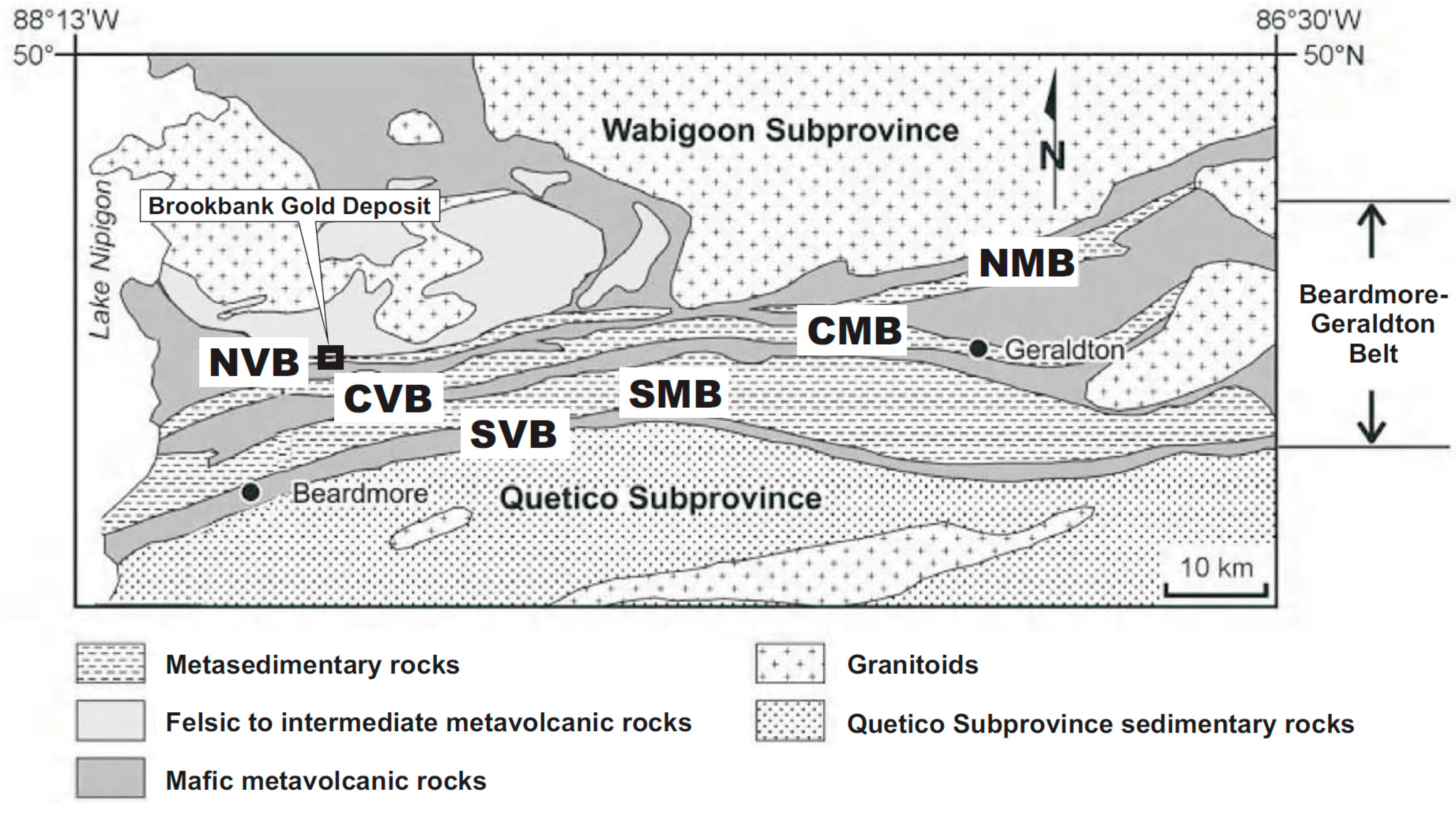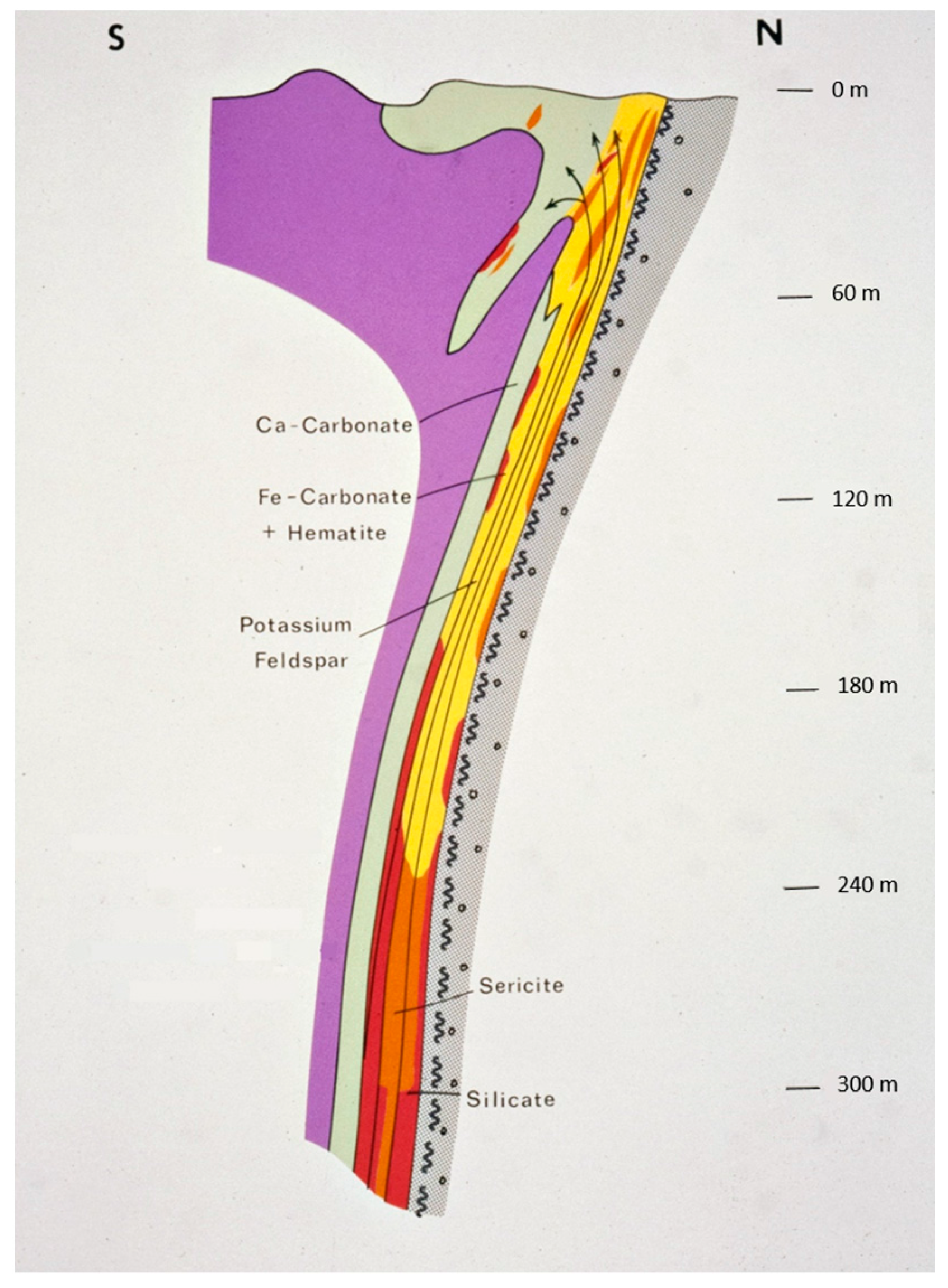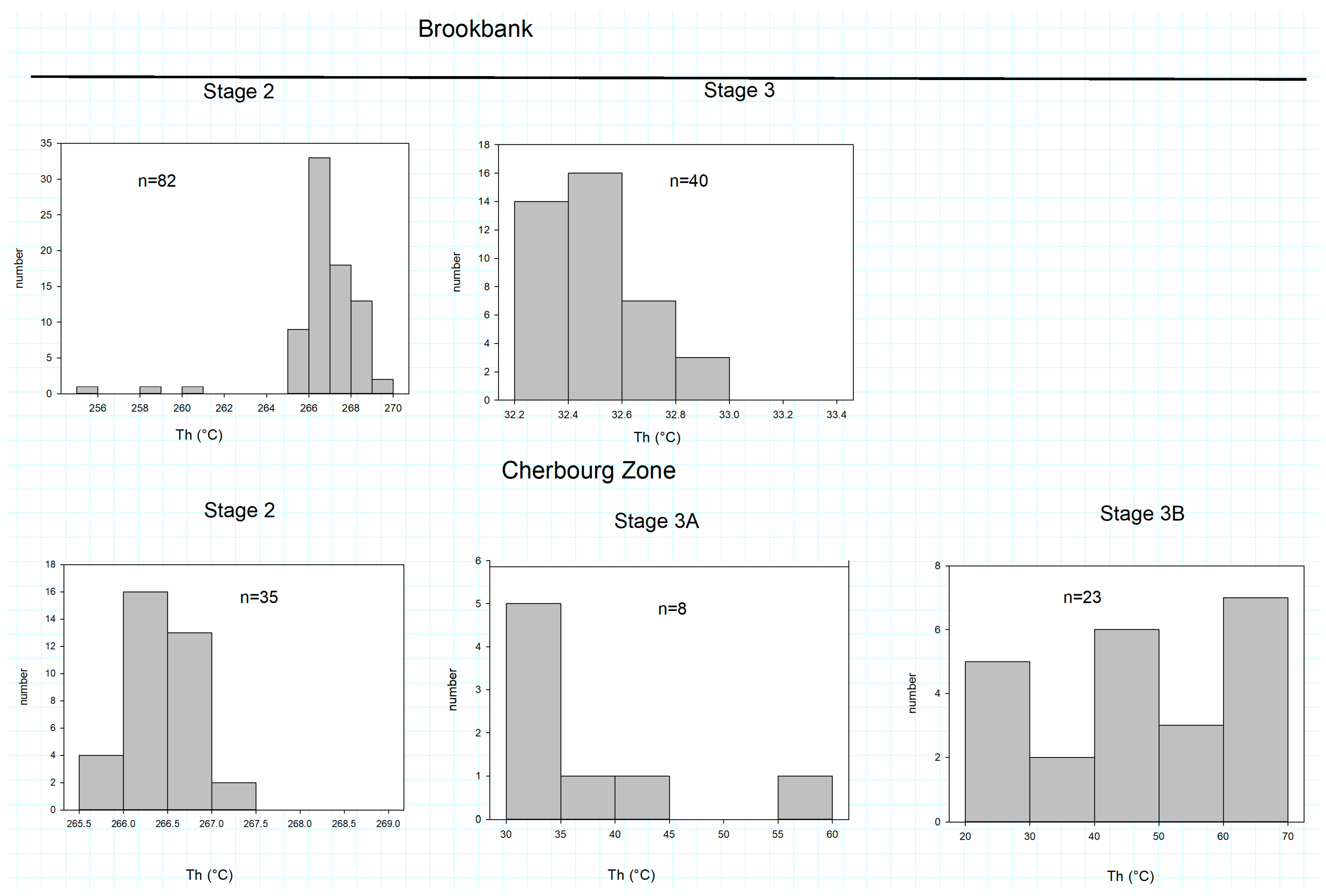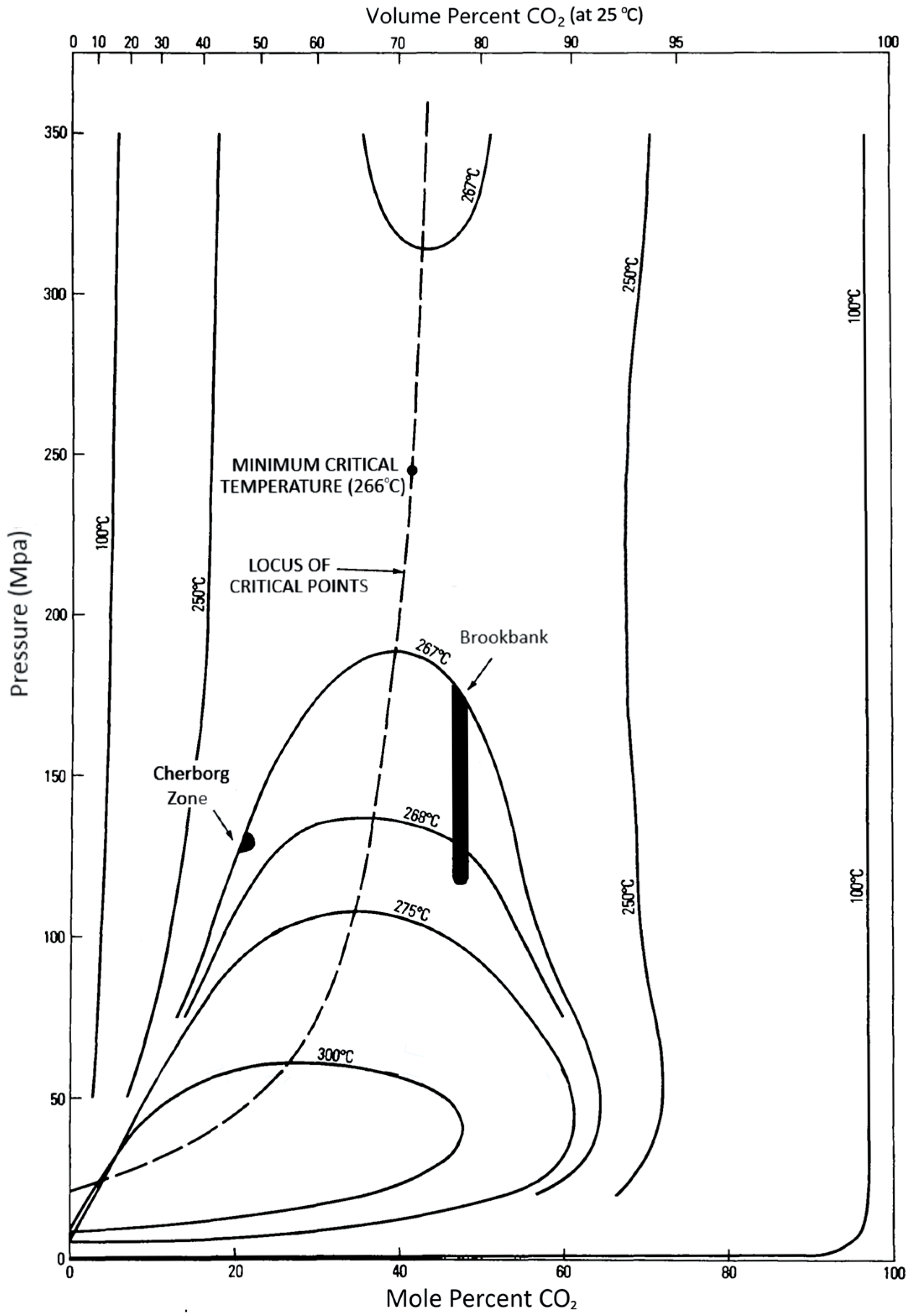A Fluid Inclusion Study of the Brookbank Deposit, Northwestern Ontario: A Transition from Mesothermal to Epithermal Gold Deposition
Abstract
:1. Introduction
2. Regional and Local Geology
2.1. Regional Geology of the Beardmore–Geraldton Greenstone Belt
2.2. Geology of the Brookbank Deposit
3. Methods
3.1. Sampling and Preparation
3.2. Analysis
4. Results
4.1. Stage 1A
4.2. Stage 1B
4.3. Stage 1C
4.4. Stage 2
4.5. Stage 3A
4.6. Stage 3B
4.7. Raman Spectroscopy Results
5. Discussion
Supplementary Materials
Acknowledgments
Author Contributions
Conflicts of Interest
References
- Greenstone Gold Mines. Development of the Trans-Canada Property. Available online: http://www.greenstonegoldmines.com/ (accessed on 16 August 2017).
- Blackburn, C.W.; Johns, G.W.; Ayer, J.A.; Davis, D.W. Wabigoon Subprovince. In Geology of Ontario; Thurston, P.C., Williams, H.R., Sutcliffe, R.H., Stott, G.M., Eds.; Ontario Geological Survey: Sudbury, ON, Canada, 1991; Special Volume 4, Part 1; pp. 303–381. ISBN 13: 9780772989761. [Google Scholar]
- Mason, J.K.; McConnell, C.D. Gold mineralization in the Beardmore-Geraldton area. In The Geology of Gold in Ontario; Colvine, A.C., Ed.; Ontario Geological Survey Miscellaneous Paper; Ontario Geological Survey: Sudbury, ON, Canada, 1983; pp. 84–97. [Google Scholar]
- Lewis, W.J.; Murahwi, C.Z.; San Martin, A.J. Technical Report on the Mineral Resource Estimates for the Hardrock, Brookbank and Keylake Projects Trans-Canada Property, Beardmore-Geraldton Area Northern Ontario. 2013. Available online: www.premiergoldmines.com/assets/docs/Trans-Canada-Version-Final-Jan-2013-(LQ).pdf (accessed on 4 July 2017).
- Ontex Resources Drilling Campaign Aimed to Enhance Open Pit Potential of 629,900 Oz Brookbank Gold Deposit. 2009. Available online: http://www.marketwired.com/press-release/ontex-resources-drilling-campaign-aimed-enhance-open-pit-potential-629900-oz-brookbank-tsx-ont-793645.htm (accessed on 11 November 2017).
- McCuaig, T.C.; Kerrich, R. P-T-t-deformation-fluid characteristics of lode gold deposits: Evidence from alteration systematics. Ore Geol. Rev. 1998, 12, 381–453. [Google Scholar] [CrossRef]
- Lindgren, W. Mineral Deposits, 4th ed.; McGraw-Hill: New York, NY, USA, 1933. [Google Scholar]
- Sibson, R.H.; Robert, F.; Poulsen, K.H. High-angle reverse faults, fluid-pressure cycling, and mesothermal gold-quartz deposits. Geology 1988, 16, 551–555. [Google Scholar] [CrossRef]
- Robb, L. Introduction to Ore-Forming Processes; Blackwell Publishing: Malden, MA, USA, 2005; ISBN 0-632-06378-5. [Google Scholar]
- Sibson, R.H. Earthquake rupturing as a mineralizing agent in hydrothermal systems. Geology 1987, 15, 701–704. [Google Scholar] [CrossRef]
- Robert, F.; Poulsen, K.H. Vein formation and deformation in greenstone gold deposits. In Structural Controls on Ore Genesis; Richards, J.P., Tosdal, R.M., Eds.; Reviews in Economic Geology; Society of Economic Geologists: Littleton, CO, USA, 2001; Volume 14, pp. 111–115. ISBN 1-887483-58-6. [Google Scholar]
- Kowalski, B.S. Petrographic and Fluid Inclusion Studies on the Metalore-Golden Highway Deposit, Thunder Bay District, Ontario. M.Sc. Thesis, Lakehead University, Thunder Bay, ON, Canada, 1994. [Google Scholar]
- Smyk, M.C.; Fralick, P.; Hart, T.R. Geology and gold mineralization of the Beardmore-Geraldton greenstone belt. In 51st Annual Meeting, Proceedings of Institute on Lake Superior Geology, Nipigon, ON, Canada, 24–28 May 2005; Hollings, P., Ed.; 51st Institute on Lake Superior Geology: Nipigon, ON, Canada, 2005; Volume 51, part 2; pp. 3–40. [Google Scholar]
- DeWolfe, J.C.; Lafrance, B.; Stott, G.M. Geology of the shear-hosted Brookbank gold prospect in the Beardmore-Geraldton belt, Wabigoon subprovince, Ontario. Can. J. Earth Sci. 2007, 44, 925–946. [Google Scholar] [CrossRef]
- Tomlinson, K.Y.; Hall, R.P.; Hughes, D.J.; Thurston, P.C. Geochemistry and assemblage accretion of metavolcanic rocks in the Beardmore-Geralton greenstone belt, Superior Province. Can. J. Earth Sci. 1996, 33, 1520–1533. [Google Scholar] [CrossRef]
- Devaney, J.R.; Fralick, P.W. Regional sedimentology of the Namewaminikan Group, northern Ontario: Archean fluvial fans, braided rivers, deltas and an aquabasin. Current. Research. Geol. Sur. Can., Pap. 85-1B 1985, 125–132. [Google Scholar] [CrossRef]
- Barrett, T.J.; Fralick, P.W. Sediment redeposition in Archean iron formation: Examples from the Beardmore-Geraldton greenstone belt, Ontario. J. Sediment. Petrol. 1985, 55, 205–212. [Google Scholar]
- Devaney, J.R. Sedimentology and Stratigraphy of the Northern and Central Metasedimentary Belts in the Beardmore-Geraldton Area of Northern Ontario. M.Sc. Thesis, Lakehead University, Thunder Bay, ON, Canada, 1987. [Google Scholar]
- Barrett, T.J.; Fralick, P.W. Turbidites and iron formation, Beardmore-Geraldton, Ontario: Application of a combined ramp/fan model to Archean clastic and chemical sedimentation. Sedimentology 1989, 36, 221–234. [Google Scholar] [CrossRef]
- Devaney, J.R.; Williams, H.R. Evolution of an Archean subprovince boundary: A sedimentological and structural study of part of the Wabigoon-Quetico boundary in northern Ontario. Can. J. Earth Sci. 1989, 26, 1013–1026. [Google Scholar] [CrossRef]
- Williams, H.R. Subprovince accretion tectonics in the south-central Superior Province. Can. J. Earth Sci. 1990, 26, 570–581. [Google Scholar] [CrossRef]
- Hart, T.R.; terMeer, M.; Jolette, C. Precambrian Geology of Kitto, Eva, Summers, Dorothea and Sandra Townships, Northwestern Ontario: Phoenix Bedrock Mapping Project; Open File Report 6095; Ontario Geological Survey: Sudbury, ON, Canada, 2002. [Google Scholar]
- Lafrance, B.; DeWolfe, J.C.; Stott, G.M. A sructural reappraisal of the Beardmore-Geraldton Belt at the southern boundary of the Wabigoon subprovince, Ontario, and implications for gold mineralization. Can. J. Earth Sci. 2004, 41, 217–235. [Google Scholar] [CrossRef]
- Roedder, E. Fluid Inclusions. In Reviews in Mineralogy; Mineralogical Society of America: Washington, DC, USA, 1984; Volume 12, ISBN 0-939950-16-2. [Google Scholar]
- Bodnar, R.J. Interpretation of data from aqueous-electrolyte fluid inclusions. In Fluid Inclusions: Analysis and Interpretation; Samson, I., Anderson, A., Marshall, D., Eds.; Short Course Series; Mineralogical Association of Canada: Ottawa, ON, Canada, 2003; Volume 32, pp. 81–100. [Google Scholar]
- Diamond, L.W. Introduction to gas-bearing fluid inclusions. In Fluid Inclusions: Analysis and Interpretation; Samson, I., Anderson, A., Marshall, D., Eds.; Short Course Series; Mineralogical Association of Canada: Ottawa, ON, Canada, 2003; Volume 32, pp. 101–158. ISBN 0-921294-32-8. [Google Scholar]
- Frape, S.K.; Fritz, P. Geochemical trends for groundwaters from the Canadian Shield. In Saline Water and Gases in Crystalline Rocks; Fritz, P., Frape, S.K., Eds.; Special Paper; Geological Association of Canada: St. John’s, NL, Canada, 1987; pp. 19–38. [Google Scholar]
- Borisenko, A. Study of the salt composition of solutions of gas-liquid inclusions in minerals by the cryometric method. Geol. Geofiz. 1977, 18, 16–27. [Google Scholar]
- Linke, W.F. Ferric chloride decahydrate: the systems FeCl3-H2O and FeCl3-HCl-H2O below 0. J. Phys. Chem. 1956, 60, 91–96. [Google Scholar] [CrossRef]
- Wilkinson, J. MgCl-H2O System. [email protected]. 1998. Available online: www.geology.wisc.edu/flincs/fi/disc/loweutec2.html (accessed on 25 January 2018).
- Cohen-Adad, R.; Lorimer, J.W. Alkali Metal and Ammonium Chlorides in Water and Heavy Water (Binary Systems); IUPAC Solubility Data Series; Pergamon Press: Oxford, UK, 1991; Volume 47. [Google Scholar]
- Dubé, B.; Gosselin, P. Greenstone-hosted quartz-carbonate veins. In Mineral Deposits of Canada; Goodfellow, W.D., Ed.; Mineral Deposits Division Special Publication; Geological Association of Canada: St. John’s, NL, Canada, 2007; ISBN 13: 978-1-897095-24-9. [Google Scholar]
- Seward, T.M. Thio complexes of gold in hydrothermal ore solutions. Geochim. Cosmochim. Acta 1973, 37, 379–399. [Google Scholar] [CrossRef]
- Renders, P.J.; Seward, T.M. The stability of hydrosulphido- and sulphido complexes of Au(I) and Ag(I) at 25°C. Geochim. Cosmochim. Acta 1989, 53, 244–253. [Google Scholar] [CrossRef]
- Shenberger, D.M.; Barnes, H.L. Solubility of gold in aqueous sulfide solutions from 150 to 350 °C. Geochim. Cosmochim. Acta 1989, 53, 269–278. [Google Scholar] [CrossRef]
- Benning, L.G.; Seward, T.M. Hydrosulphide complexing of Au(I) in hydrothermal solutions from 150–400 °C and 500–1500 bars. Geochim. Cosmochim. Acta 1996, 60, 1849–1871. [Google Scholar] [CrossRef]
- Wood, S.A. Application of a multiphase ore mineral solubility experiment to the separation of base metal and gold mineralization in Archean greenstone terrains. Econ. Geol. 1987, 82, 1044–1048. [Google Scholar] [CrossRef]
- Romberger, S.B. Transport and deposition of gold in hydrothermal systems. In Greenstone Gold and Crustal Evolution; Robert, F., Sheahan, P.A., Green, S.B., Eds.; NUNA Conference Volume; Geological Association of Canada, Mineral Deposits Division: St. John’s, NL, Canada, 1991; pp. 61–66. ISBN 0-919216-43-9. [Google Scholar]
- Phillips, G.N. Pressure-temperature environments and the causes of gold deposition. In Greenstone Gold and Crustal Evolution; Robert, F., Sheahan, P.A., Green, S.B., Eds.; NUNA Conference Volume; Geological Association of Canada, Mineral Deposits Division: St. John’s, NL, Canada, 1991; p. 193. ISBN 0-919216-43-9. [Google Scholar]
- Hu, F.F.; Fan, H.R.; Jiang, X.H.; Li, X.C.; Yang, K.F.; Mernagh, T. Fluid inclusions at different depths in the Shandandao gold deposit, Jiaodong Peninsula, China. Geofluids 2013, 13, 528–541. [Google Scholar] [CrossRef]
- Bethke, C.M.; Marshak, S. Brine migrations across North America-the plate tectonics of groundwater. Annu. Rev. Earth Planet. Sci. 1990, 18, 287–315. [Google Scholar] [CrossRef]
- Harper, D.A.; Longstaffe, F.J.; Wadleigh, M.A.; McNutt, R.H. Secondary K-feldspar at the Precambrian–Paleozoic unconformity, southwestern Ontario. Can. J. Earth Sci. 1995, 32, 1432–1450. [Google Scholar] [CrossRef]
- Hassler, S.W.; Simonson, B.M. Deposition and alteration of volcaniclastic strata in two large, early Proterozoic iron-formations in Canada. Can. J. Earth Sci. 1989, 26, 1574–1585. [Google Scholar] [CrossRef]
- Brown, P.E. Fluid inclusion modeling for hydrothermal systems. In Techniques in Hydrothermal Ore Deposits Geology; Richards, J.P., Larson, P.B., Eds.; Reviews in Economic Geology; Society of Economic Geologists: Littleton, CO, USA, 1998; Volume 10, pp. 151–171. [Google Scholar]
- Hendel, E.M.; Hollister, L.S. An empirical solvus for CO2-H2O-2.6 wt% salt. Geochim. Cosmochim. Acta 1981, 45, 225–228. [Google Scholar] [CrossRef]
- Hedenquist, J.W.; Henley, R.W. The importance of CO2 on freezing point measurements of fluid inclusions: Evidence from active geothermal systems and implications for epithermal ore deposition. Econ. Geol. 1985, 80, 1379–1406. [Google Scholar] [CrossRef]
- Roedder, E.; Bodnar, R.J. Geologic pressure determinations from fluid inclusion studies. Annu. Rev. Earth Planet. Sci. 1980, 8, 263–301. [Google Scholar] [CrossRef]
- Phillips, G.N. Gold and alteration in the Golden Mile, Kalgoorlie. Econ. Geol. 1986, 81, 779–808. [Google Scholar] [CrossRef]
- Zezin, D.Y.; Migdisov, A.A.; Williams-Jones, A.E. The solubility of gold in hydrogen sulfide gas: An experimental study. Geochim. Cosmochim. Acta 2007, 71, 3070–3081. [Google Scholar] [CrossRef]
- Zezin, D.Y.; Migdisov, A.A.; Williams-Jones, A.E. The solubility of gold in H2O-H2S vapour at elevated temperature and pressure. Geochim. Cosmochim. Acta 2011, 75, 5140–5153. [Google Scholar] [CrossRef]
- Duan, Z.; Møller, N.; Weare, J.H. Equation of state for the NaCl-H2O-CO2 system: Prediction of phase equilibria and volumetric properties. Geochim. Cosmochim. Acta 1995, 59, 2869–2882. [Google Scholar] [CrossRef]






| Drill Hole | Maximum Depth (m) | Minimum Depth (m) |
|---|---|---|
| B49 | 189.1 | 154.5 |
| B56 | 226.2 | 203.3 |
| B58 | 265.8 | 241.4 |
| B53 | 303.9 | 271.3 |
| B43 | 323.7 | 306.9 |
| B50 | 417.3 | 399.0 |
| B54 | 512.1 | 497.4 |
| B61 | 586.1 | 581.3 |
| B46 | 768.0 | 743.7 |
| Stage | Brookbank | Cherbourg Zone |
|---|---|---|
| Stage 1A | 30 inclusions: type 1 and 3 Te: −22.0 to −22.9 Tm ice: −0.1 to −6.6 Th: 220.1 to 235.3 | 42 inclusions: type 1 and 3 Te: −21.1 to −22.9 Tm ice: −0.4 to −0.5 Th: 220.3 to 231.1 Tm clath *: 10.4 to 10.6 |
| Stage 1B | 15 inclusions: type 3 Te: −52.1 to −52.8 Tm ice: −0.3 to −0.8 Th: 230.1 to 266.4 | 35 inclusions: type 1 and 3 Te: −50.1 to −53.4 Tm ice: −0.4 to −0.5 Th: 229.3 to 231.0 |
| Stage 1C | 57 inclusions: type 1 and 3 Te: −55.0 to −55.9 Tm ice: −0.3 to −0.8 Th: 353.5 to 364.2 | Not observed |
| Stage 2 | 82 inclusions: type 4A and 4B Te: −33.9 to −35.8 Tm ice: 0.1 to −8.8 Th: 258.3 to 269.1 | 35 inclusions: type 4A and 4B Te: −35.0 to −35.9 Tm ice: −0.1 Th: 265.8 to 267.1 Tm clath *: 10.5 |
| Stage 3A | 40 inclusions: type 3 Te: −56.3 Tm ice: −0.7 to −8.3 Th: 32.3 to 32.9 | 8 inclusions: type 3 Te: −54.9 to −56.6 Tm ice: −0.9 Th: 32.0 to 55.9 Tm clath *: 10.4 |
| Stage 3B | Not observed | 23 inclusions: type 3 Te: −14.1 to −15.9 Tm ice: −1.1 to −1.2 Th: 21.6 to 69.8 |
| Fluid Inclusion Terminology |
| Te = eutectic temperature Tm ice = melting temperature of ice Tm clath = melting temperature of clathrate Th = temperature of homogenization |
| Types of Fluid Inclusions (Phases present at room temperature) |
| Type 1: Laq + V Type 2: LCO2 + VCO2 Type 3: Laq + VCO2 + H2O Type 4A: Laq + : LCO2 + V Type 4B: Laq + : LCO2 + V + S |
| Laq = H2O + dissolved chloride S = unidentified unreactive solid |
| Sample No. | Th °C | Homog. Phase | Tm Ice °C | Relative Age | Stage * |
|---|---|---|---|---|---|
| BSK-B43-1043 | 266.5 | L | −0.5 | older | 2 |
| 32.5 | L | −0.9 | younger | 3A | |
| BSK-B46-2447 | 266.9 | L | −0.4 | oldest | 2 |
| 266.2 | L | −0.4 | younger | 2 | |
| 32.3 | V | −0.9 | younger | 3A | |
| 32.5 | L | −0.9 | youngest | 3A | |
| BSK-B46-2472 | 266.1 | L | −0.5 | oldest | 2 |
| 267.3 | V | −0.9 | younger | 2 | |
| 32.9 | V | −0.9 | younger | 3A | |
| 32.6 | V | −0.7 | youngest | 3A | |
| BSK-B58-826 | 268.2 | V | −0.5 | oldest | 2 |
| 266.4 | V | −0.4 | younger | 2 | |
| 32.9 | V | −4.3 | youngest | 3A | |
| BSK-B50-950 | 356.4 | V | −0.4 | older | 1C |
| 32.6 | V | −1.4 | younger | 3A |
| Inclusion No. | Inclusion Type | Stage | Te | Tm Ice | Th | Homog Phase | Tm Clath | Phases Detected |
|---|---|---|---|---|---|---|---|---|
| 1 | 3 | 1 | −21.8 | −0.4 | 221.4 | L | 10.5 | CO2 |
| 2 | 3 | 1 | −21.8 | −0.4 | 221.4 | L | 10.5 | CO2 |
| 3 | 4A | 2 | −35.3 | −0.1 | 266.2 | V | - | H2O |
| 4 | 4A | 2 | −35.3 | −0.1 | 266.1 | V | - | H2O |
| 5 | 4A | 2 | −35.2 | −0.1 | 266.3 | V | - | H2O, N2 |
| 6 | 3 | 3 | −15.9 | −1.1 | 66.6 | L | - | CO2, N2 |
| 7 | 3 | 3 | −15.9 | −1.1 | 66.3 | L | - | CO2, N2 |
© 2018 by the authors. Licensee MDPI, Basel, Switzerland. This article is an open access article distributed under the terms and conditions of the Creative Commons Attribution (CC BY) license (http://creativecommons.org/licenses/by/4.0/).
Share and Cite
Kowalski, B.; Kissin, S. A Fluid Inclusion Study of the Brookbank Deposit, Northwestern Ontario: A Transition from Mesothermal to Epithermal Gold Deposition. Minerals 2018, 8, 92. https://doi.org/10.3390/min8030092
Kowalski B, Kissin S. A Fluid Inclusion Study of the Brookbank Deposit, Northwestern Ontario: A Transition from Mesothermal to Epithermal Gold Deposition. Minerals. 2018; 8(3):92. https://doi.org/10.3390/min8030092
Chicago/Turabian StyleKowalski, Barbara, and Stephen Kissin. 2018. "A Fluid Inclusion Study of the Brookbank Deposit, Northwestern Ontario: A Transition from Mesothermal to Epithermal Gold Deposition" Minerals 8, no. 3: 92. https://doi.org/10.3390/min8030092




